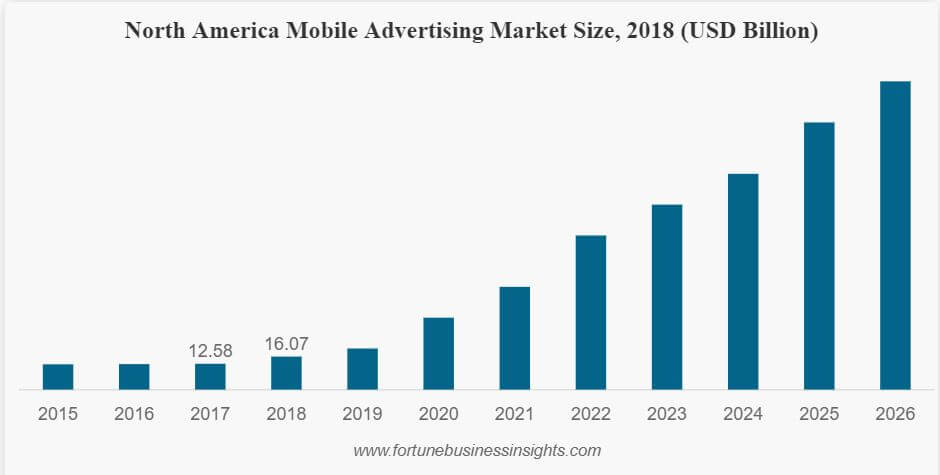Advertisers need to know the best way to connect with consumers, and these days people are increasingly using their mobile devices. Research shows there are now 5.16 billion unique mobile users worldwide and growing at an annual rate of 2.5 percent.
Mobile advertising revenue in 2022 reached 195.1 Billion which makes up 69 percent of the overall online ad revenues. These numbers show that mobile advertising is central to digital marketing and one of the most effective mobile marketing tools to target a large number of potential customers.
Since mobile advertising is relatively new compared to traditional advertising, the many platforms and options can seem intimidating for the uninitiated. To get you up to speed, we are introducing you to the basics of mobile advertising, why it’s important, and mobile advertising best practices to help you build your brand and boost your revenues.
The Basics of Mobile Advertising: How Does It Work?
Let’s start with the basics. Mobile advertising refers to the promotion of products and services using paid ad spaces which will appear on smartphones and mobile devices. Ads for phones and other mobile devices can range from SMS to banner ads in websites and downloaded apps. The potential for ROI is huge, especially since market analysts predict mobile advertising market share to reach $408.58 billion by 2026.

The great thing about advertising in mobile is that they can be tailored to a user’s browsing history. This makes phone ads or mobile ads highly targeted with potentially high conversion rates compared to traditional companies advertising which does not guarantee that they will reach your target audience.
Before discussing the different types of mobile advertising, here are some important terms you need to know:
Terms for currency
- Pay Per Click (PPC), or Cost per Click (CPC), refers to the advertising fee each time the ad is clicked
- Cost per Impression (CPI) is the fee for each new view of the ad
- Cost per Action (CPA) is the fee each time a specific action is completed (e.g. app installs, product purchases, add-to-carts)
- Cost per View (CPV) is the fee for each instance a video campaign gets played
- Cost per Mile (CPM), or Cost per Thousand (CPT), is the advertising cost for every thousand views or clicks
- Click-Through Rate (CTR) refers to the overall clicks divided by impressions. This measures the effectivity of the ad
- Conversion Rate (CR) refers to the percentage of users who completed a desired action, whether it’s an app download, a sign up, or a purchase
- Install Rate (IR)refers to the percentage of users who installed an app
Types of Mobile Advertising
Mobile ads come in different formats. You can use all of the types of mobile advertising to cover all grounds, but some forms are better suited to a product than others. What’s important is that you know about your different options, so you can choose the best mobile advertising formats to reach your ad campaign targets.

1. Display Advertising
A display ad, also banner ad, is the simplest form of mobile advertising. These dedicated ad spaces can usually be found in websites or apps as images with text designed to grab the user’s attention. It also includes a call to action, urging users to click the ad and go to the advertiser’s landing page. The simplicity and cheap cost of production makes this ad format a popular mobile advertising for small business.
Pricing: Mobile Advertising CPM, CPC, CPI, CPA
Pros: Cost effective and simple, high compatibility across platforms and devices, fast deployment
Cons: Static and doesn’t maximise mobile capabilities for rich media, low user intent, “Banner Blindness” syndrome
2. Video Advertising
Video ads are short videos, usually 30 seconds, which can be seen embedded in websites or in-app. They may appear in streaming platforms like YouTube before, in the middle or after the actual video you are watching. They usually contain links to their products or more information about the campaign.
Pricing: CPC, CPA
Pros: Engaging and dynamic
Cons: Might be disruptive to some viewers, expensive production costs
3. Native Advertising
Native ads, just like display ads, are embedded in the website or the app. This gives other developers or brands the opportunity to sell ad space in their app for extra revenue. These are usually the ads you see while reading an article for example or while scrolling through Pinterest or Facebook’s news feed. They usually blend in with the naturally environment of the app, so there is no interruption to user experience.
Pricing: CPC
Pros: Cannot be blocked, less intrusive
Cons: Easily ignored, low user intent
4. Full-Screen Mobile Advertising
Full-screen mobile advertising, also called Interstitial advertisement, as evident in the name are those videos or graphics that usually play on full screen when you open an app or as transitions during different levels or intervals in a mobile game.
Pricing: CPC
Pros: High impressions and conversions, high user intent, visually engaging, larger space
Cons: Highly intrusive, can mess with navigation, higher production costs
5. Search Advertising
People are searching for different things all the time, so advertisers can buy search ads for their product or service to appear in the search results based on specific keywords. These are usually the sponsored results you see at the top of the page on Google, Bing, or Baidu.
Pricing: CPC bid
Pros: High conversion rate, high user intent
Cons: High competition, high CPC
6. Gamified Mobile Advertising
Gamified ads are the most interactive and also most complex to create. These are usually used by mobile game advertisers to persuade players to download the game. The ad could be a snippet of the game which allows the user to play as a teaser before leading to a link where they can download the actual game.
Pricing: CPV, CPI, CPA
Pros: High conversion rates, high user intent
Cons: Requires programming for ad gamification, more expensive production costs
Advantages and Disadvantages of Mobile Advertising
What makes mobile advertising effective? Mobile advertising is the future, it’s as simple as that. With the added effect of the pandemic, people are all the more dependent on mobile phones to stay connected and to entertain themselves.
Traditional advertising is basically like casting a wide net over a specified location hoping to catch fish. Mobile advertising, on the other hand, deploys nets in multiple areas and the fish aren’t moving—you have a captive audience. Still not convinced. Here are some of mobile advertising’s advantages:

ADVANTAGES
Cost-Effective
Unless you’re creating a gamified mobile ad or a video, mobile advertising is cheap. Even with videos, mobile advertising cost is far cheaper than traditional advertising, like a radio or TV ad, which has both expensive airtime as well as production costs. For image or graphics, you can even use a free app like Canva, for example, to create the ad at no extra cost.
Real-Time and Precise Targeting
Since people carry their mobile phones everywhere, mobile advertising can target your potential customers in real-time. The latest data from “We Are Social” report show that people spend an average of three hours and 22 minutes on their mobile phones each day, and mobile advertising on cell phone allows you to connect to this captive audience.
Mobile advertising also uses geotagging for precise location-based ads. People searching for nearby restaurants, for example, can find your business in the search results if you purchased search ads. Since they are already searching for businesses like yours and they’re already in the area, the chances of attracting these customers will be much higher.
Instant Responses and Transactions
When you see an ad on the television, you may need to call the number or make use of another channel to inquire about a product or purchase something. In mobile advertising, responses and transactions are instantaneous. A single click can take them to your online shop and complete a transaction through mobile payment options.
Personalised Content
Since mobile advertisements use browsing behaviour and personal data (in some instances) to customise ads they see, you can tailor your ads to fit their profile for maximum engagement. The latest AI technology makes this process extremely effective. The Power of Personalization: AI’s Role in Tailoring Mobile Ads
Shareable Content
Sure, you can take a picture of a billboard and send to your friends, but sharing mobile advertising is infinitely easier and it already comes with a direct link to the product or service. Sharing these ads in different social media platforms also broadens your ad’s reach. With a funny or engaging ad, you can even go viral.
Data Tracking
These days, data is king and mobile advertising has excellent data collection features. Mobile advertising can instantly track each time a user interacts with your ad. This also comes with other mobile advertising metrics for different user data which you can use to polish your campaign. Lags or errors in your ad can also be corrected instantly based on user feedback or response.
Multiple Uses
The versatility of mobile advertising is another advantage. It’s not just for selling goods and services, you can also use mobile ads for collecting user feedback through surveys, polls, or similar data collection mechanisms. You’ll be able to know what works and what doesn’t work with your messaging. Perhaps an ad is offensive or problematic to certain consumers, so you can instantly take it down before it snowballs into a PR problem. Gamified mobile ads can also double as a contest or a game, giving users the chance to win something while you increase opt ins.
DISADVANTAGES
Compatibility Issues
Since there are a lot of mobile devices, varying sizes and different operating systems, there will be compatibility issues. Your ad may appear fine in an iPhone but cut off in an Android phone or iPad. Unfortunately, making multi-platform campaigns can limit you from taking full advantage of a specific device’s features.
Mobile Ads Can Be Blocked
Ad interruptions can be annoying; hence some users use ad-blocking software. Research shows that there are now around 700 million devices running ad blockers which makes it a big problem for mobile advertisers. Unlike TV ads when you can just walk away and do something else during the commercials, mobile ads tend to pop up while you are watching a video or reading an article. In some cases, ads can cause navigational issues. Frustrated mobile users may block your ad as a result.
Going Viral for the Wrong Reasons
Going viral is a double-edged sword and when your mobile ad becomes viral for the wrong reasons, this can create huge PR problems that could permanently tarnish your brand.
How to Create Advertising on Mobile
You can find mobile ads in different websites, apps, and streaming services. Fortunately, there are services to help you create content for your ad and ad platforms to distribute your ad.
With banner ads, you’ll find many services offered to simplify the process. It can be as simple as 3 steps: choosing a size and template for your chosen platform, design with graphics and text, then save and download the completed graphic. Meanwhile, video ads and interstitial ads will require more work to produce.
Once you have the ad content, you can select the best ad networks and platforms to manage your advertising campaign.

Best Mobile Ad Networks and Platforms
A mobile ad platform, also called a mobile ad network, is what advertisers use to purchase ad spaces to be published in specific mobile websites and apps. The top mobile platforms, like Facebook and Google, provide a dashboard for ad management to help you manage and publish your ad campaigns. This ad panel will also show you the data collected, including CTR, impressions, conversions, etc.
Mobile ad networks and platforms also lets you set a budget for your ad campaign based on your chosen currency, CPC, or CPM. These are the top mobile ad networks and platforms to consider for your next mobile advertising campaign:
Google Ads
Google Ads support text and image ads as well as graphic and video ads. Since Google is a widely used search engine, advertisers can reach a large audience especially when it comes to search advertising. Aside from Google search results, you can also use Google Ads to publish your ads within apps and browsers.
Facebook/Instagram Ads
Another popular platform with a large user base is Facebook which can cross-post ads to the equally popular app, Instagram. Facebook launched Audience Network for an all-in-one ad management platform. This ad network supports, banner ads, mobile native advertising, video ads, and interstitial ads.
Bing Ads
Though not as big as Google, Bing provides big savings for billions of searches done every month. Plus, it’s partnership with Kindle gives you access to a specific market which may provide more conversions for you. If you are advertising a book or reader-friendly products, this would make more sense for you.
AdMob
AdMob has been acquired by Google and has quickly become a popular mobile ad network. This is an ideal choice for in-app mobile advertising. Ads shown by AdMob are based on user’s choices of relevant ads. Supported mobile advertising formats are banner, video, native, and interstitial ads.
AdColony
Another popular mobile ad network is AdColony. Mobile game companies and big-name brands use AdColony for in-app video ads. The interstitial ads you see while playing your mobile games are probably managed by AdColony. This platform can deploy targeted ads based on mobile OS, type of mobile device, connection type, location, demographics, and content.
Best Mobile Advertising Strategies
Even though mobile advertising is enjoying rapid growth, not all mobile ad campaigns will be effective. This type of digital advertising is still relatively new and evolving, so advertisers have a lot of factors to consider. We have compiled some of the tried and tested mobile advertising strategies to get the most out of your mobile ad campaign.
Go Straight to the Point
Keep it simple and concise. As an advertiser, you only get a limited amount of time to make an impression to users—seconds at best. Add the small screens of mobile devices and you really have to convey your message with visual appeal and as little text as possible.
Use Location-Based Ads
“Think Local” is an important guidepost for advertisers. This is especially true with mobile advertising. Mobile ad spaces are already crowded with advertisers hoping to make an impression, so instead of competing in a saturated mobile market, remember that users are interested in content relevant to their location, so use geotargeting for a more effective campaign.
Use Rich Content and Interactive Formats
Mobile users have short attention spans, that’s why you need to employ more engaging and interactive ads to catch their attention. Data show that mobile advertising video has the highest CTR at 11.8 percent, while native ads and display ads are only at 1.37 and 0.35 percent respectively.
Know Your Audience
The first rule about advertising is to know your market. A well-targeted mobile ad campaign has the most potential for success. The good thing about mobile advertising is that you can be as specific as possible, from location and demographics to device type and user behaviour. You can target gamers by placing in-app ads in popular games, while fashion aficionados may be on Instagram, Pinterest, and Depop. Don’t narrow your options too much though, or you might miss out on other potential customers.
Optimise Your Ad
One of the main reasons why users install ad blockers is because ads, especially rich media and video ads, can drain the battery and take up a lot of RAM thus slowing down the device. That said, it’s important to reduce loading time for your ad. Make sure your ad is light with high compatibility to avoid slow loading.
Best Mobile Advertising Online Courses and Sources
Now that you’re up-to-speed with the basics in mobile advertising, you may be interested in some advanced learning materials. Fortunately for you, mobile advertising and mobile marketing courses are at the tip of your fingertips. Check out the following sources to become a pro in mobile ads strategy.
UDemy
Pricing: From $12.99
What you’ll learn:
- How to obtain 1,000,000+ app downloads
- The best strategies for app monetization
- How to boost user retention, mobile advertising user engagement, reviews and reduce uninstalls
Pricing: From $12.99
What you’ll learn:
- Pass 2 AdWords certification exams with at least 90% score
Pricing: From $12.99
What you’ll learn
- How to set up professional Facebook mobile ads with high conversion rates
- Learn about KPIs (key performance indicators)
- Learn how to do split testing, optimise delivery, placement, and audience
Lynda
Pricing: Free for 1 month
What you will learn:
- Display advertising basics
- Using the AdSense app
Pricing: Free for 1 month
What you will learn:
- Setting up a business account
- Creating ads and campaigns
- Managing ads and campaigns in bulk with Ads Manager and Excel
- Split testing
- Retargeting and remarketing
Pricing: Free for 1 month
What you will learn:
- Creating a business account
- Three targeting options using Facebook Ads Manager
- Define reach and impressions
- Determine ad campaign success and effectivity
Pricing: Free for 1 month
What you will learn:
- Maximise PPC performance
- Bid and budget optimisation
- Modifying campaigns in bulk
- Google Ads scripts to automate tasks
Google training
Pricing: Free
What you’ll learn:
- Mobile Insights
Pricing: Free
What you’ll learn:
- Find free online product training and certifications
- Google Ads
- Google Marketing Platform
- Google Ad Manager
- Google My Business
- Google AdMob
Mobile Advertising Trends in 2023
Whether you’re launching a mobile ad campaign or starting a career in digital advertising, here are some trends to look out for:

More Mobile Video Aps
Mobile Marketer predicts a 72 percent increase in video advertising. The popularity of streaming platforms like Twitch, YouTube, and Netflix shows that younger users are consuming more video content than the older generation. This makes this format poised for growth in the coming months and years.
Increased In-App Advertising
Users are increasingly using apps as part of their daily mobile device usage, hence in-app advertising is expected to increase. Research show that people use apps even when they are not actively using their phones. For example, they play podcasts and audio books while commuting and other pockets of time. This presents a unique opportunity for app developers to monetize their apps by offering in-app mobile advertising.
Data Privacy and Transparency
Even though users like personalised content, they are increasingly wary about data privacy. Marketers and advertisers will move towards transparency in using consumer data. Getting explicit user consent to collect data will become more important as institutions create regulations to protect individual data privacy.
AI and Machine Learning
More and more data are collected by ad networks and platforms, so it makes sense that there’s a growing trend towards automation and machine learning. Artificial intelligence combined with machine learning can help analysts identify user behaviour and patterns more quickly. At the same time, the insights can further improve and personalise ads.
VR and AR Advertising
More advertisers are using virtual reality and augmented reality to promote products especially in the gaming industry. The immersive quality provides richer experience for users which will hopefully lead to conversions. At this point, barrier to entry is still high as there is no mass adoption of VR headsets yet, but experts expect this to change as more people adopt this new technology.
We are now in the mobile-first world when it comes to digital advertising. IAB UK proves this claim as mobile spending soared from GB38 million to GBP 6.6 billion in less than a decade. As mobile advertising market size grows, it continues to provide new and innovative ways to reach your customers. Therefore, you must also learn to adapt in order to keep your market engaged and your brand relevant.
